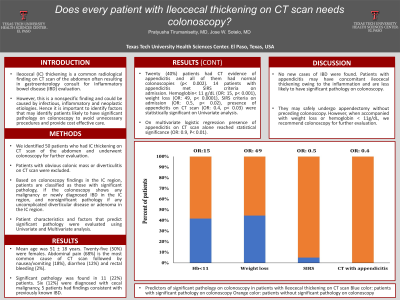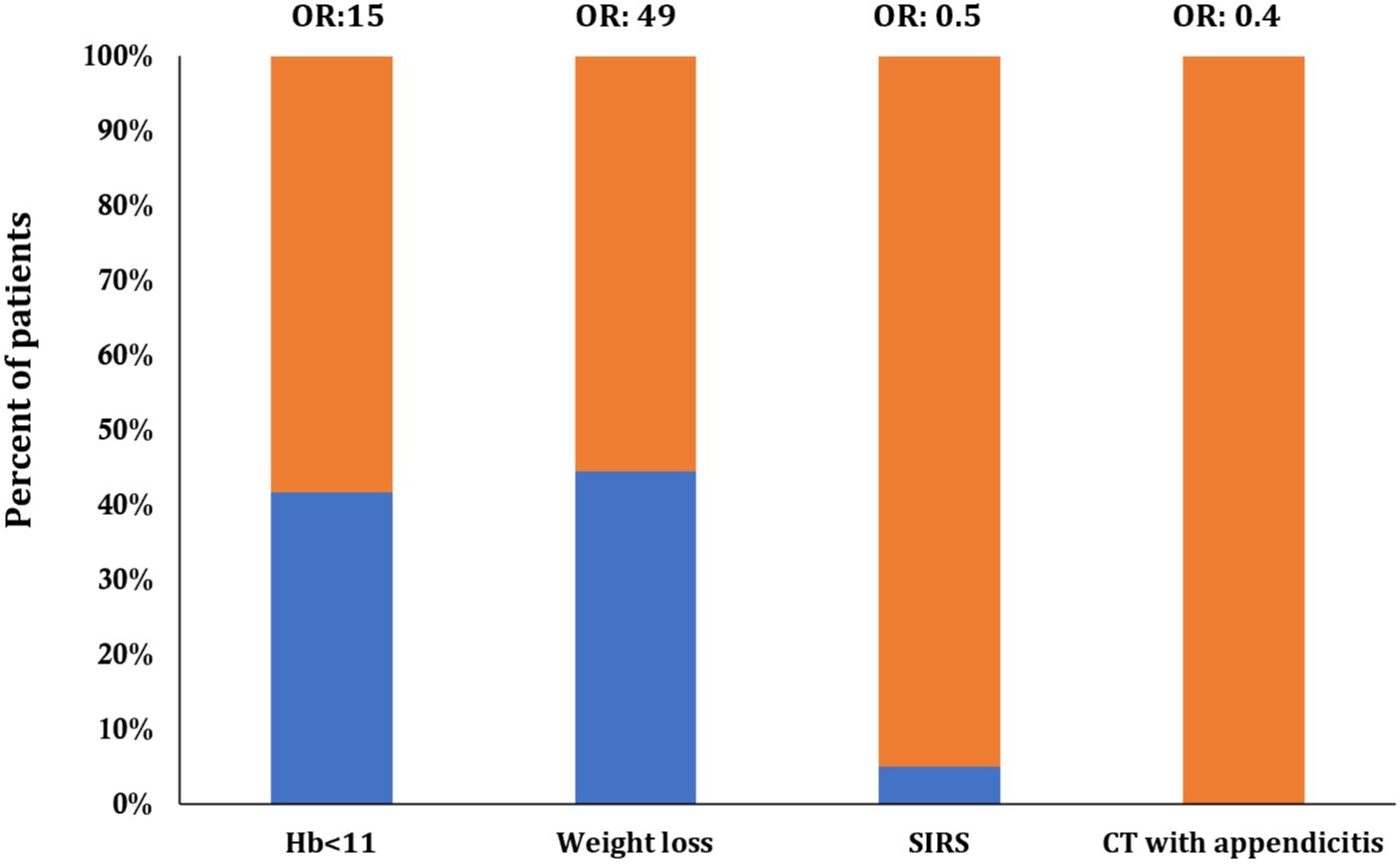Tuesday Poster Session
Category: Colon
P3042 - Does Every Patient With Ileocecal Thickening on CT Scan Needs Colonoscopy?
Tuesday, October 24, 2023
10:30 AM - 4:00 PM PT
Location: Exhibit Hall

Has Audio
- JS
Jose W. Sotelo, MD
Texas Tech University Health Sciences Center
El Paso, TX
Presenting Author(s)
Pratyusha Tirumanisetty, MD1, Jose W. Sotelo, MD2
1Brooklyn Hospital Center, Brooklyn, NY; 2Texas Tech University Health Sciences Center, El Paso, TX
Introduction: Ileocecal (IC) thickening is a common radiological finding on CT scan of the abdomen often resulting in gastroenterology consult for Inflammatory bowel disease (IBD) evaluation. However, this is a nonspecific finding and could be caused by infectious, inflammatory and neoplastic etiologies. Hence it is important to identify factors that may identify patients likely to have significant pathology on colonoscopy to avoid unnecessary procedures and provide cost effective care.
Methods: We identified 50 patients who had IC thickening on CT scan of the abdomen and underwent colonoscopy for further evaluation. Patients with obvious colonic mass or diverticulitis on CT scan were excluded. Based on colonoscopy findings in the IC region, patients are classified as those with significant pathology, if the colonoscopy shows any malignancy or newly diagnosed IBD in the IC region, and nonsignificant pathology if any uncomplicated diverticular disease or adenoma in the IC region. Patient characteristics and factors that predict significant pathology were evaluated using Univariate and Multivariate analysis.
Results: Mean age was 51 ± 18 years. Twenty-five (50%) were females. Abdominal pain (68%) is the most common cause of CT scan followed by nausea/vomiting (18%), diarrhea (12%) and rectal bleeding (2%). Significant pathology was found in 11 (22%) patients. Six (12%) were diagnosed with cecal malignancy, 5 patients had findings consistent with previously known IBD. Twenty (40%) patients had CT evidence of appendicitis and all of them had normal colonoscopies (p< 0.002). 14 patients with appendicitis met SIRS criteria on admission. Hemoglobin< 11 g/dL (OR: 15, p< 0.001), weight loss (OR: 49, p< 0.0001), SIRS criteria on admission (OR: 0.5, p< 0.02), presence of appendicitis on CT scan (OR: 0.4, p< 0.03) were statistically significant on Univariate analysis. On multivariate logistic regression presence of appendicitis on CT scan alone reached statistical significance (OR: 0.9, P< 0.01).
Discussion: ]No new cases of IBD were found. Patients with appendicitis may have concomitant ileocecal thickening owing to the inflammation and are less likely to have significant pathology on colonoscopy. They may safely undergo appendectomy without preceding colonoscopy. However, when accompanied with weight loss or hemoglobin < 11g/dL, we recommend colonoscopy for further evaluation.

Disclosures:
Pratyusha Tirumanisetty, MD1, Jose W. Sotelo, MD2. P3042 - Does Every Patient With Ileocecal Thickening on CT Scan Needs Colonoscopy?, ACG 2023 Annual Scientific Meeting Abstracts. Vancouver, BC, Canada: American College of Gastroenterology.
1Brooklyn Hospital Center, Brooklyn, NY; 2Texas Tech University Health Sciences Center, El Paso, TX
Introduction: Ileocecal (IC) thickening is a common radiological finding on CT scan of the abdomen often resulting in gastroenterology consult for Inflammatory bowel disease (IBD) evaluation. However, this is a nonspecific finding and could be caused by infectious, inflammatory and neoplastic etiologies. Hence it is important to identify factors that may identify patients likely to have significant pathology on colonoscopy to avoid unnecessary procedures and provide cost effective care.
Methods: We identified 50 patients who had IC thickening on CT scan of the abdomen and underwent colonoscopy for further evaluation. Patients with obvious colonic mass or diverticulitis on CT scan were excluded. Based on colonoscopy findings in the IC region, patients are classified as those with significant pathology, if the colonoscopy shows any malignancy or newly diagnosed IBD in the IC region, and nonsignificant pathology if any uncomplicated diverticular disease or adenoma in the IC region. Patient characteristics and factors that predict significant pathology were evaluated using Univariate and Multivariate analysis.
Results: Mean age was 51 ± 18 years. Twenty-five (50%) were females. Abdominal pain (68%) is the most common cause of CT scan followed by nausea/vomiting (18%), diarrhea (12%) and rectal bleeding (2%). Significant pathology was found in 11 (22%) patients. Six (12%) were diagnosed with cecal malignancy, 5 patients had findings consistent with previously known IBD. Twenty (40%) patients had CT evidence of appendicitis and all of them had normal colonoscopies (p< 0.002). 14 patients with appendicitis met SIRS criteria on admission. Hemoglobin< 11 g/dL (OR: 15, p< 0.001), weight loss (OR: 49, p< 0.0001), SIRS criteria on admission (OR: 0.5, p< 0.02), presence of appendicitis on CT scan (OR: 0.4, p< 0.03) were statistically significant on Univariate analysis. On multivariate logistic regression presence of appendicitis on CT scan alone reached statistical significance (OR: 0.9, P< 0.01).
Discussion: ]No new cases of IBD were found. Patients with appendicitis may have concomitant ileocecal thickening owing to the inflammation and are less likely to have significant pathology on colonoscopy. They may safely undergo appendectomy without preceding colonoscopy. However, when accompanied with weight loss or hemoglobin < 11g/dL, we recommend colonoscopy for further evaluation.

Figure: Predictors of significant pathology on colonoscopy in patients with Ileocecal thickening on CT scan
Blue color: patients with significant pathology on colonoscopy
Orange color: patients without significant pathology on colonoscopy
Blue color: patients with significant pathology on colonoscopy
Orange color: patients without significant pathology on colonoscopy
Disclosures:
Pratyusha Tirumanisetty indicated no relevant financial relationships.
Jose Sotelo indicated no relevant financial relationships.
Pratyusha Tirumanisetty, MD1, Jose W. Sotelo, MD2. P3042 - Does Every Patient With Ileocecal Thickening on CT Scan Needs Colonoscopy?, ACG 2023 Annual Scientific Meeting Abstracts. Vancouver, BC, Canada: American College of Gastroenterology.
